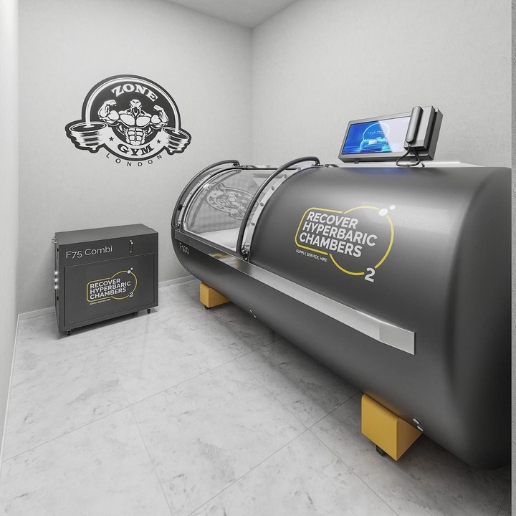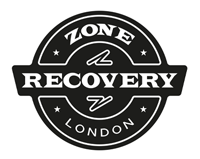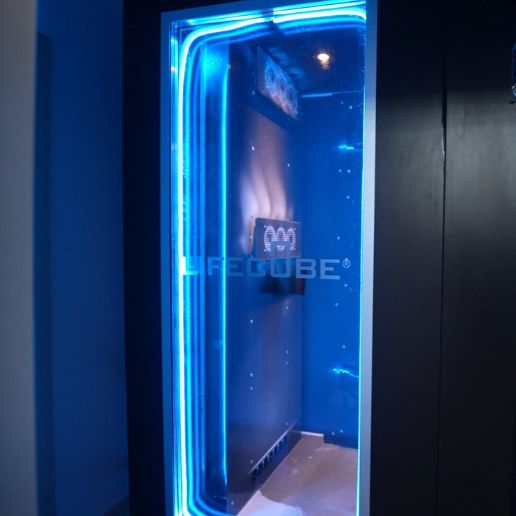Book Hyperbaric Oxygen Chamber In London
WHAT IS HYPERBARIC OXYGEN THERAPY
Hyperbaric Oxygen Therapy (HBOT) is a treatment in which oxygen at an ambient pressure higher than atmospheric pressure is applied. The equipment required for hyperbaric oxygen treatment consists of a pressure chamber, which may be of rigid or flexible construction, and a means of delivering 100% oxygen. Operation is performed to a predetermined schedule by trained personnel who monitor the patient and may adjust the schedule as required. At Zone Recovery we have the F100 flagship model made by Recover Hyperbarics with a very spacious and comfortable chamber, intercom telephone system to communicate with our staff should you need to while inside the chamber.

WHAT ARE THE PHYSIOLOGICAL BENEFITS TO HYPERBARIC OXYGEN THERAPY
- IMPROVE ENERGY LEVELS AND TISSUE FUNCTION
The human body is highly energetic and depends on a constant flow of oxygen to help generate enough cellular energy ( called ATP) for all its metabolic needs. In essence, ATP is the body’s currency for energy and the more the body has, then the more it can ‘spend’ and oxygen has a direct relationship to the amount of cellular ATP produced.
Simply put, HBOT provides the body with an extra large dose of oxygen, that then has the ability to facilitate extra ENERGY to be manufactured within all our metabolically-active cells. and tissue inside the body. Atherosclerosis (narrowing and hardening of the arteries) affects all of us, but its affects are much more pronounced the older we get. As the blood vessels get narrow d, the rate and flow of oxygen tends to proportionately get lower. The consequences can be seen with low energy levels and a general tendency to “slow down”. HBOT can help produce a significant rise in cellular energy levels and therefore may be a valuable tool to help combat this age-related disease.
In damaged tissue, this extra amount of oxygen may help to provide the ‘critical extra energy’ needed for both tissue repair and function.
In addition, long-term benefits may occur as the body is able to increase the number of sites where the ATP is produced. These areas inside the cells are called mitochondria and the addition of HBOT has been shown to increase mitochondrial biogenesis and further the production of cells to generate ATP. - REGENERATE TISSUE
The extra oxygen facilitates the body’s ability to produce both new TISSUE and new BLOOD VESSELS. This is not only essential for damaged areas & injuries inside the body, but more importantly, to help combat the degenerative effects that occur during the aging process.
- New TISSUE: Hyperbaric oxygen therapy is well known in hospitals and wound care centres for skin collagen & tissue regeneration. The 2 major physiological effects of HBOT to provide this benefit are:
- Fibroblast Activation: Fibroblasts are the cells that are responsible for laying down collagen and essential for collagen production. Hyperbaric oxygen stimulates fibroblast activation and therefore plays a critical and crucial role in the treatment of non-healing wounds.
- Stem Cell Mobilization: Stem cell therapy has been the focus of major research and funding for regenerative medicine. HBOT is a powerful way to stimulate the bone marrow to produce more stem cells. These cells then can circulate in the blood stream and end up in many different places where they are needed.
One exciting development in clinical research has shown us that hyperbaric oxygen therapy can be a potent stimulator of Neurogenesis (new brain cells), particularly following brain injuries or movement disorders. All other tissue and organs can benefit from this process, right down to the bones (osteogenesis — new bone formation)!
A second exciting development is in the field of regenerative medicine where hyperbaric oxygen therapy is successfully being used in combination with stem cell procedures (like PRP). HBOT both helps (before the procedure) increase the number of stem cells harvested before the procedure as well as promote and enhance growth and transplantation post procedure.
Hyperbaric oxygen therapy has also been reported to speed up healing and provide quicker repair from injuries. Furthermore (and sometimes more importantly), the soft tissue repaired through this procedure has been documented to be much stronger & more tensile. This can have a profound impact, particularly in athletes or those that are more susceptible to re-injuring the same tissue.
Repeated exposures of HBOT have been shown to cause a strong parasympathetic response. This is the active part of the nervous system during rest, digestion, and repair. So while HBOT provides so many benefits for tissue repair and regeneration, it also has been documented to activate the body’s natural environment for this to occur.4. New BLOOD VESSELS: Another key therapeutic value of hyperbaric therapy is in helping the body to create new blood vessels; this can provide long term circulatory benefits that are critical for recovery from diseases, particularly in those that effect the small blood vessels (and commonly observed in):
-chronic and non-healing wounds
-brain injuries
-heart attacks
-diabetes
The aging process (aging and older blood vessels quite commonly have atherosclerotic plaque build up and restrict blood flow. The body naturally tries to create new blood vessels and natural bypasses — HBOT helps to facilitate this process) HBOT’s role in helping the body create new blood vessels has been linked to the following 2 mechanisms:Angiogenesis: This is a normal process of the body realizing that it needs to produce new capillaries and blood vessels, mainly due to hypoxic (low oxygen) signalling. The addition of hyperbaric oxygen therapy has actually supported the body’s ability to grow new blood vessels from areas where circulation has been compromised and limited.
Vasculogenesis: This is an exciting added benefit that has been demonstrated from HBOT and is the where blood vessels are produced basically ‘from scratch’ (‘de novo’ in medical terms). This is through HBOT’s ability to stimulate the bone marrow to produce new stem cells (as previously discusses) and in this case they are blood vessel cells!
- REDUCE INFLAMATION
The extra oxygen also allows for a significant reduction in both SWELLING and INFLAMMATION: SWELLING: Typically following acute (or very recent) tissue injuries, the blood vessels get ‘leaky’ so that white blood cells and can pass through to help fight any infections and clean up the debris and mess (apoptosis) that can be persistent in chronic (or long term) tissue injuries. The only problem with this model is that the fluid in the blood also makes its way into the tissue and causes swelling and can impede the oxygen levels needed. With the addition of HBOT, the oxygen levels are so high, that the body constricts the blood vessels going to the damaged regions, now allowing for less fluid to enter this area; thereby reducing the swelling, while kick-starting the repair of the tissue. INFLAMMATION: One of the key beneficial effects noted from HBOT has been the profound reduction in inflammation and their associated markers (including TNF-alfa, Interleukin-1, and many more) inside the body. The levels of these inflammatory markers have been linked to the progressions, severity, and control of many very serious inflammatoryrelated conditions and this has spearheaded the growth in the pharmaceutical industry to help develop agents that can lower these markers. In addition, HBOT has been shown to increase Interleukin-10 (a very strong anti-inflammatory protein) which is clinically important particularly in the brain (neuroinflammation). HBOT’s overall role in reducing inflammation can have a dramatic benefit on both: Acute (or very recent) inflammatory disorders, like acute pancreatitis, can be very serious so its impact on health can be potentially life-saving. Chronic (or long-term) inflammation, which has been implicated in a wide variety of health concerns from heart & cardiovascular disease (inflammation in the arteries), to Alzheimer’s disease, and right down to even the progression of cancers.
- REDUCE PAIN (PARTICULARLY INFLAMMATORY-RELATED PAIN DISORDERS)
Numerous studies have clearly demonstrated a dramatic relief in pain, following hyperbaric procedures. This has been supported by patients, world-wide, reporting strong and similar pain-relief following HBOT.
The majority of the evidence point to the anti-inflammatory effects being the key mechanism for this therapeutic effect. It must be noted that 1/5th of North Americans are reported to be suffering from inflammatory-related pain disorders, so the significance cannot be understated. Add to this, the growing number of individuals that are being prescribed NSAIDS and either cannot tolerate the meds, or are putting themselves at risk for long-term risks associated with continual usage. With the rise in baby-boomers and life expectancy, these medications are becoming more prevalent and being taken for unprecedented periods of time!
New emerging data is now confirming an opioid-like effect following HBOT. This contributing factor can help explain HBOT’s powerful and dramatic pain-reliving effects that have been so well documented in clinical studies. This also can give us a much better understanding of HBOT’s full potential in pain management strategies.
- IMPROVE AND ENHANCE IMMUNE FUNCTIONING
The immune system is composed of white blood cells (WBCs). These cells have a variety of essential roles inside the body, one of which is to fight infections. They do this through an oxygen-dependent system called phagocytosis This is a process whereby WBCs engulf and then kill the invading organisms. The killing effect is achieved through converting oxygen into dangerous compounds called oxy-radicals. HBOT has been shown to enhance phagocytosis, helping the body to kill and ward-off infections.
HBOT also aids in a process called apoptosis (or programmed cell death). This is where more susceptible cells (like older and poor functioning immune cells or cancer cells) basically are forced to ‘commit suicide’ and make way for newer cells. This also has been shown to be an important factor in resolving inflammation and chronic wounds.
High enough oxygen dosages (as typically produced in high-pressure oxygen chambers) can produce very high amounts of oxygen radicals. These compounds (on their own) can have a direct killing effect on microorganisms, particularly anaerobic bacteria (bacteria that can’t live in the presence of oxygen).
- PROTECT THE BODY
Each cell in your body is well equipped to be able to protect its vital core (DNA) by having an internal antioxidant system. These antioxidants are called ‘endogenous’ antioxidants because they are produced by the body to handle the constant stress that it is under, just from day-to-day living.
Actually, just breathing causes a significant stress on every cell called ‘metabolic stress’. The reason is that oxygen is reacting with carbon (from the food that you eat) to give the body cellular energy (ATP) it needs for survival and function. However, this production causes dangerous byproducts. Since we breathe multiple times in a minute, we have always been exposed to ‘the stress of breathing’ and naturally our body has adapted to this! Every cell is protected via this endogenous antioxidant system. Without these, our cells would not even be able to survive the act of breathing!
In recent decades, the cells in our body are being exposed to unprecedented levels of stressors — fast food, car exhaust, cigarette smoke and industrial chemicals — just to name a few. As these begin to overwhelm our natural and built-in antioxidant system, our fragile DNA now has less protection from these attacks and many disease states can follow. This has lead to a strong push for nutritional antioxidant supplementation in an effort to help combat these diseases.
HBOT provides a strong and very quick rise in the endogenous antioxidant system. The key antioxidants Glutathione Peroxidase, Catalase, and Superoxide Dismutase have all shown to rise intracellularly in virtually all metabolically-active tissue following HBOT exposure. This can give enhanced cellular protection for both current and future exposures:
- Current Exposures: Implications for chronic health conditions like cancers, heart disease, and other very serious diseases can be huge, both from a clinical viewpoint and also from its potential overall cost-saving effect.- Note, many doctors and practitioners who are not aware of the research that has been done on HBOT are quick to theorize that HBOT will produce free radical damage through the addition of extra oxygen and will either not recommend it due to this or prescribe very high amounts of antioxidants to counteract this. However, this is not the case! In actuality, it can help reduce free radical damage inside the body through its stimulation of the body’s natural antioxidant system.
- Future Exposures: This is a very interesting and exciting area in HBOT research for its potential clinical role in limiting the tissue damage that occurs following serious injuries or disease states (like those seen following heart attacks, strokes, car accidents, liver damage, etc).Many of these studies have involved preconditioning an organ (like the brain) with HBOT, and then exposing it to an injury (like a stroke) and observed the subsequent damages. The studies have concluded an overall protective effect from HBOT, with much less damage occurring in those that were preconditioned with hyperbaric therapy. Just imagine the clinical implications for aging and disease. You can never predict that a serious accident can happen, but now with the understanding of HBOT, the potential of prevention is possible.




